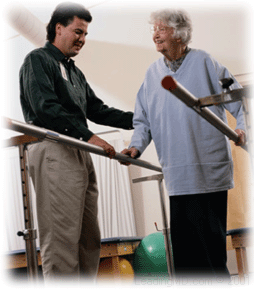






 Non-operative
recovery:
Non-operative
recovery:
Conservative measures, as described above, are used until they no longer
provide adequate pain relief, and the functions of daily living become
severely limited. Non-operative treatment usually results in some improvement
in pain, endurance, and function. Very often non-operative treatment can
not be indefinite.
Operative recovery:
Since arthritis or degenerative conditions within the hip are usually
progressive, hip replacement surgery is often the choice when non-operative
treatments no longer work.
Initial care of the hip replacement incision includes keeping it clean and
dry for 7-14 days, followed by suture or staple removal. Certain precautions
should be taken to prevent dislocation during the first 8 weeks. These are:
An exercise program is usually recommended
for general conditioning of the leg during the rehabilitation process.
Most patients, including those with non-cemented implants, are placed
on protective weight-bearing with either crutches or a walker for 6-8
weeks following hip replacement surgery. The total recovery time, including
return of muscle function, normalization of gait and improvement in
quality of life may take 6-9 months. The pain relief from hip replacement
surgery is usually immediate and long-lasting.
Follow-up
The fact that hip replacement components are artificial makes it especially
important for the patient to return to the physician office for follow-up
on a regular basis. Most physicians recommend annual follow up to assess
the condition of the prosthesis, and evaluate the bone for underlying
wear. An X-ray and physical examination will usually reveal any problems.
Follow-up visits can help prevent devastating complications from loosening,
wear, or fracture around the prosthesis.br>
![]()
![]()